Spillman Farmer Architects Receive AIA Pennsylvania Award for ArtsQuest Center at SteelStacks
By Bustler Editors|
Tuesday, Apr 10, 2012
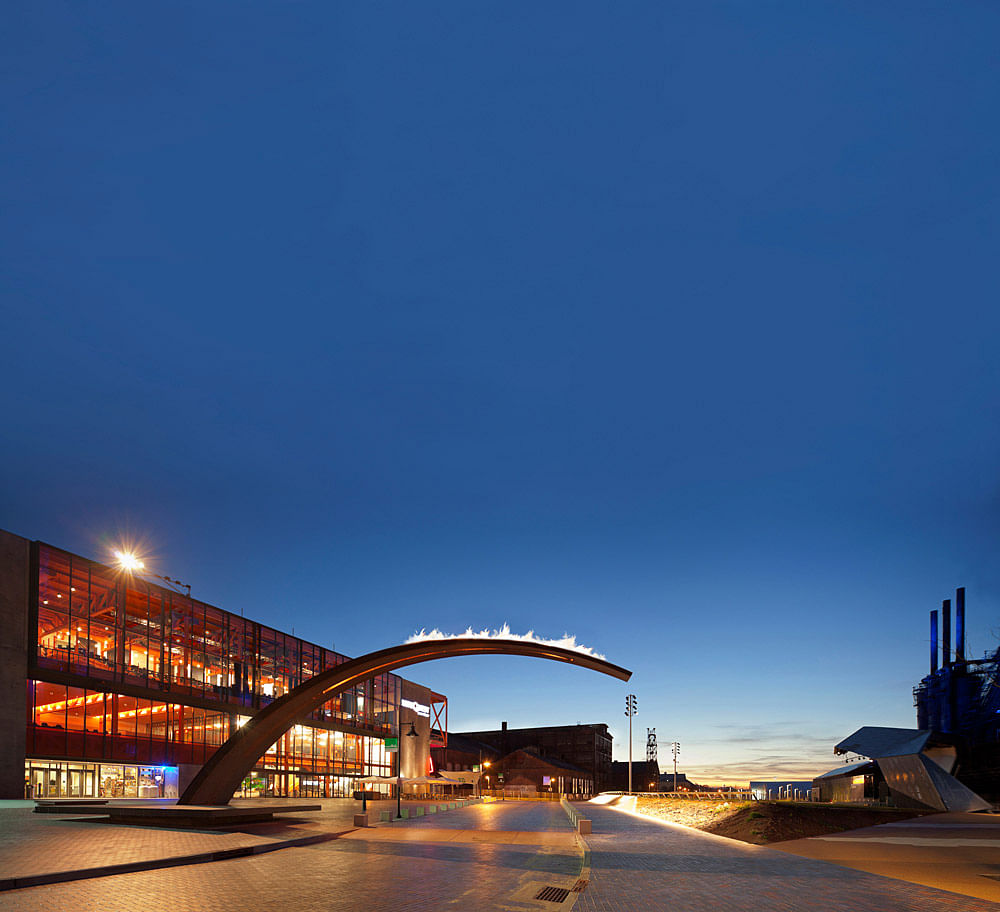
Related
Back in February 2010, we had the chance to publish first renderings and plans of the, then under construction, ArtsQuest Center at SteelStacks, a performing arts, media, and cultural center located on the landmark Bethlehem Steel site in eastern Pennsylvania. Now, with the center finally completed, the American Institute of Architects Pennsylvania has awarded a Silver Medal, the organization's highest honor, to the building's designers, Spillman Farmer Architects.
The Center lies at the foot of the abandoned Bethlehem Steel blast furnaces, 200-foot industrial ruins that tower above the country's largest privately-owned brownfield. The project represents a new type of hybrid building for the arts: it is part performance space, exhibition venue and art cinema. The building is an anchor for the revitalization effort in the City of Bethlehem, transforming a once-abandoned historic industrial core into a dynamic, sustainable, and livable mixed-use community.
AIA jurors praised the project saying, "The design captures the energy and utilitarian beauty that the best of the industrial revolution once offered. At the same time it demonstrates the power that a truly successful marriage of architecture and program can exert in bringing new purpose and hope to the most abandoned parts of our community."
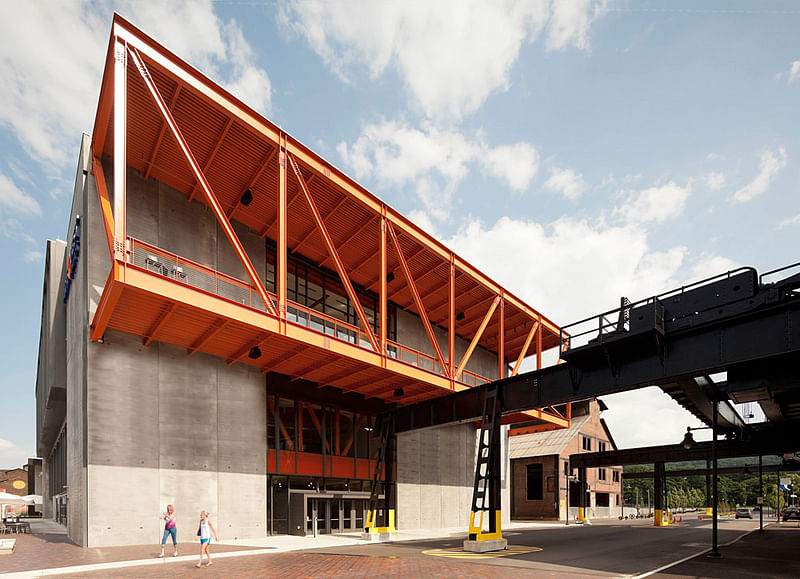
Spillman Farmer Design Principal Joseph N. Biondo responded, saying, "The architecture of the ArtsQuest Center is influenced by its industrial site. It embraces our region and its culture, recognizing the material and human spirit that fueled the industry of this country. It is an honor to be recognized by the AIA for our dedication to craft and human-centered design," Biondo continued, "As a firm, we see this project as an expression of structure, material, and site."
The Center continues to be home to over 300 live performances yearly. With such a vibrant performance schedule and a continued community presence, the ArtsQuest Center has become the cultural incubator of a region that is reinventing itself for the post-industrial age.

Project Description from the Architects:
The Bethlehem Steel Corporation was one of the most iconic companies of the Industrial Revolution. At its height, Bethlehem Steel was the second-largest steel producer in the United States and one of the largest shipbuilding companies in the world. The company occupied nearly 2000 acres in the heart of Bethlehem (PA) and employed thousands of people over many generations. While the plant ceased operations in 1995, its iconic 285-foot blast furnaces still stand as civic markers amongst the remaining industrial architecture found on the site. Today, these historic ruins tower over the largest privately owned brownfield in the United States. In recent years, the site has undergone a major revitalization effort which is transforming this once-abandoned area into a dynamic, sustainable, and livable mixed-use community.
At the foot of the majestic ruins lies the ArtsQuest Center. The 68,000 SF Center is a hybrid building which houses flexible performance space, exhibition venues, art cinemas, educational space, food venues, retail, and a community commons. The building plays a critical role in the creation of a vibrant public space in Bethlehem’s urban core, hosting over 300 live performances yearly. The ArtsQuest Center has become the cultural incubator of a region that is reinventing itself for the post-industrial age.
The architecture of the ArtsQuest Center is influenced by both the principles of Critical Regionalism and its former industrial site. The project embraces material and craft over abstract concept, recognizing the raw material and human spirit that fueled the Industrial Revolution. The building takes its cues from the site’s larger context, with authentic materials that speak to the history of the place and embracing an economy and function consistent with the industrial typology of Bethlehem Steel.



The building is wrapped with locally manufactured pre-cast concrete panels, which are mounted with their rough, handscreed surface facing outward. The panels celebrate both the process and the people that produced them by revealing the marks of their production. Their mottled color and uneven surface, reminiscent of the scale and texture of the steelmaking process, will be transformed through the passage of the sun and seasons. The rough, textural concrete panels contrast with the building’s exterior corners. Corners are functionally and elegantly articulated with inset steel that protects the panel and recalls a prominent detail of the site’s industrial buildings.
The primary building envelope serves not only as skin, but also as a load-bearing element which participates in a hybrid structural system. The mass of the panel system organizes the parti, allowing for the highly public performance and gathering space to be acoustically isolated from the service core that houses the cinemas, kitchen, mechanical, and back-of-house spaces. Inserted within this structural concrete strong box is a robust skeletal steel frame that completes the hybrid system and honors the site’s steelmaking history. This skeleton is finished in International Orange, an iconic color borrowed from the structures fabricated by Bethlehem, most notably the Golden Gate Bridge.
The building’s glass and concrete exterior is oriented along an east-west axis to stand toe-to-toe with the now-silent blast furnaces. The message of the project is carried forward by its interior architecture. Visitors are brought into intimate connection with the iconic blast furnaces, which stand proudly as a permanent and ever-present backdrop for the building’s activities.
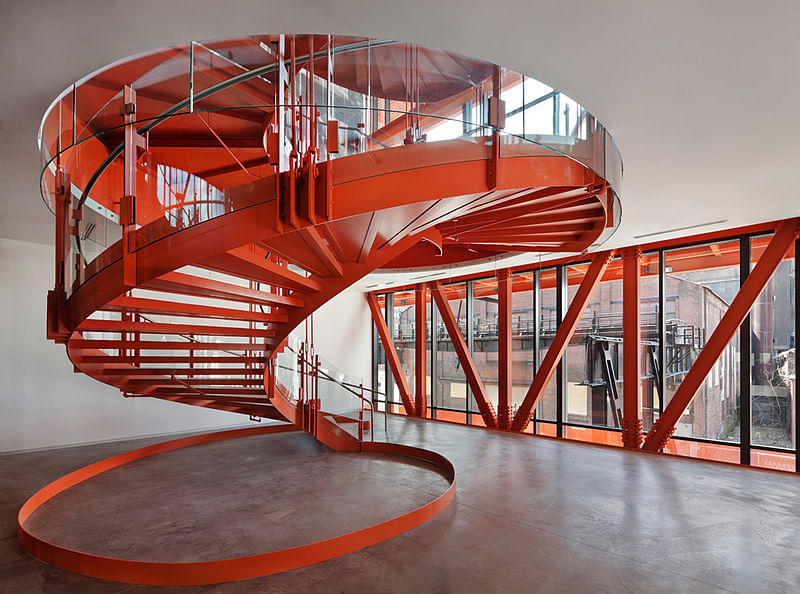
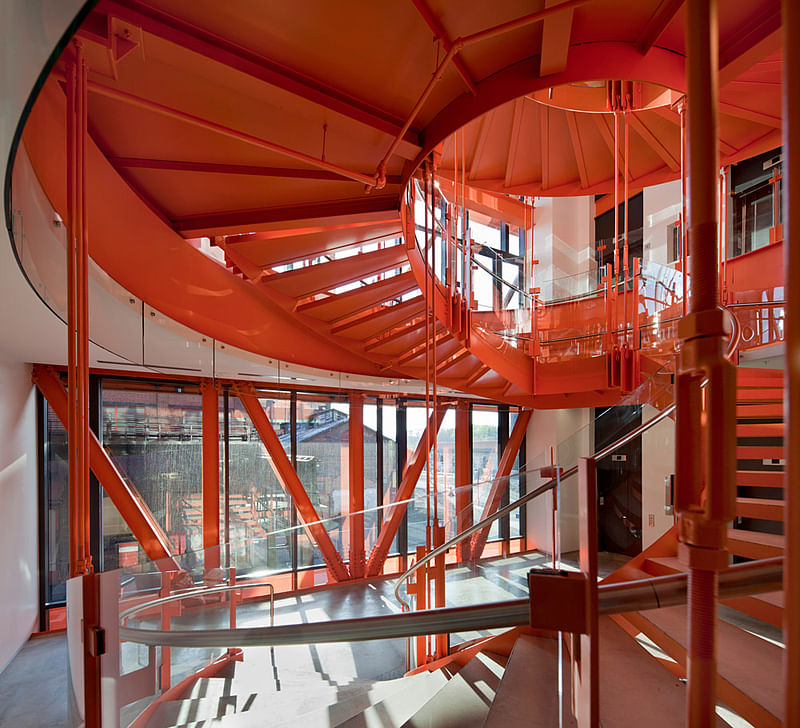

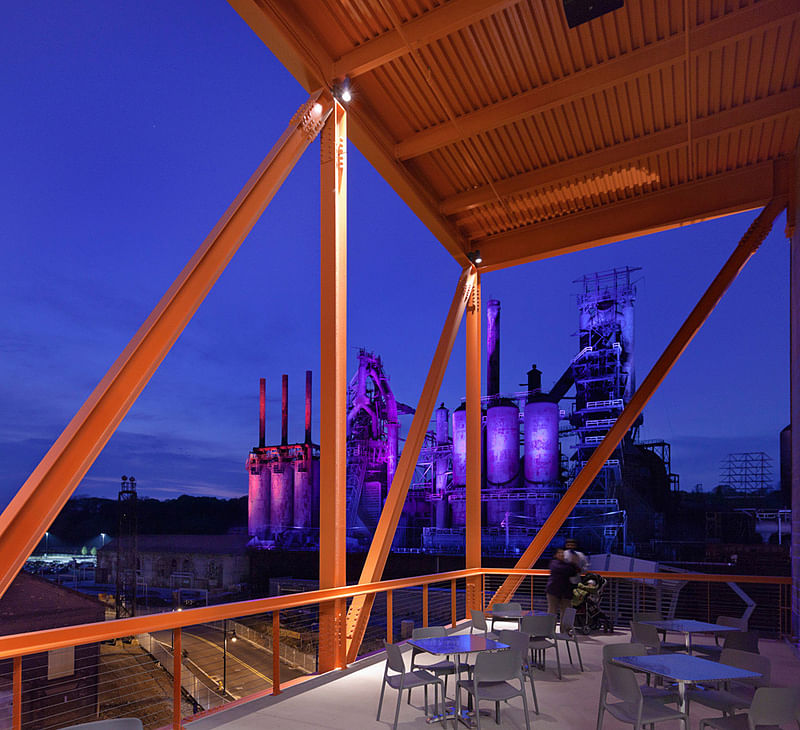
In an attempt to convey the powerful emotion and reverence of this industrial heritage, particular attention was paid to the human experience of moving through space. Each major threshold is marked by a shroud, a vernacular doorway form found in many of the site’s industrial buildings. Visitors enter through the shroud and experience successively increasing ceiling heights until a soaring two-story volume is revealed. In this way, a visitor’s passage through the building becomes a journey of discovery enriched by spatial and tactile experiences.
Programmatic elements are articulated as objects placed within the factory-like volumes of the building. These wood objects are clad in native Pennsylvania Ash stained dark on one side and left naturally light on the other. The overall effect of this surface treatment evokes the dark steel furnaces whose interiors are lined with lightcolored firebrick. The natural ash warms the building’s interiors and heightens users’ experience of circulation. Much like the exterior, the interior wood details are woven, revealing the material’s thickness.
The grand stair acts as a conveyance system, similar to those found throughout the plant. The stair starts as a plinth rising up from the earth and becomes structurally and visually lighter at each turn. At the second level, the stair takes on a circular shape, a detail drawn from the steel stairs that circle the nearby blast furnaces.
The design team worked to create a humancentered experience that allows visitors to interact with and connect to the rough, weathered physicality of the brownfield as both a historical place and a contemporary site. The result is a building that honors its history and contributes to the unique and profoundly meaningful spirit of the region.

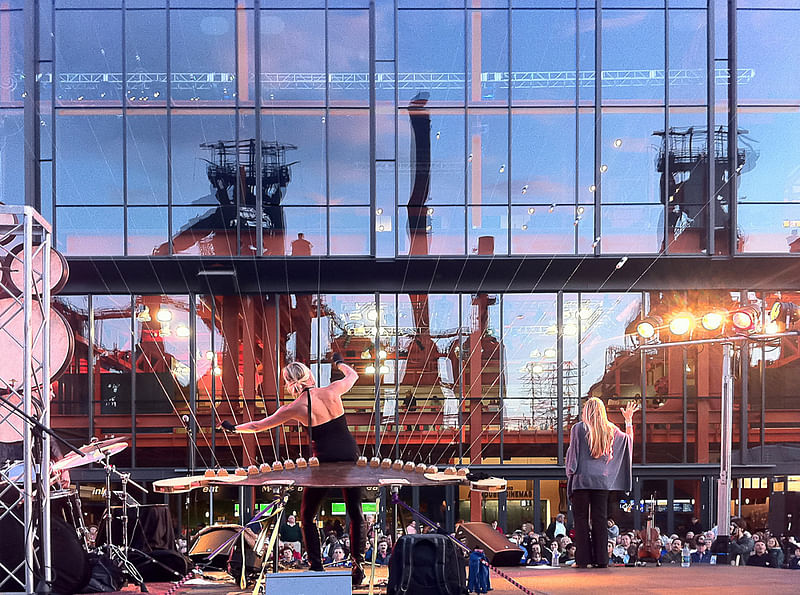
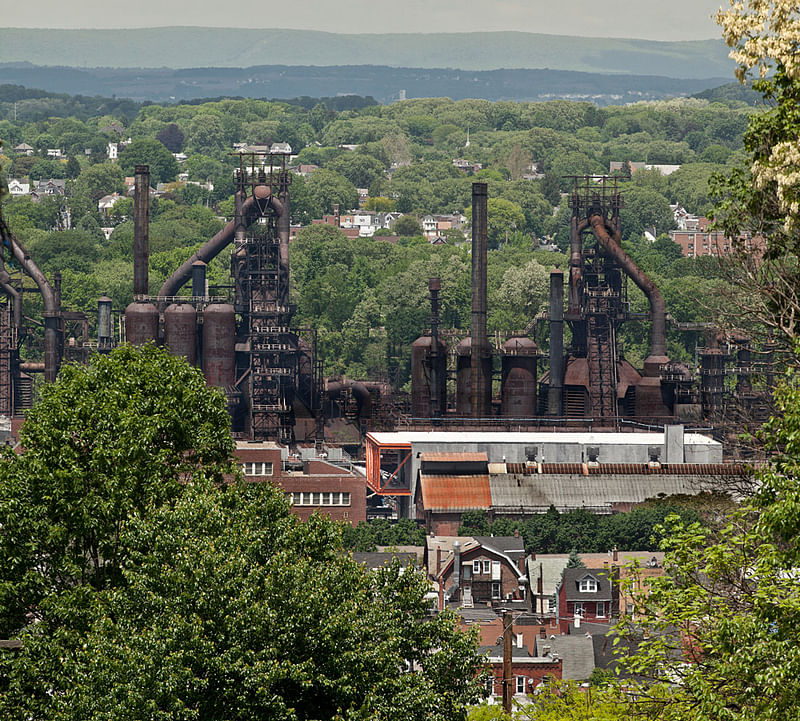
Project Details & Credits:
Project: Artsquest Center at SteelStacks
Location: Bethlehem, PA
Client/Owner: Artsquest
Architect: Spillman Farmer Architects
Project Team: Barry Pell, AIA, Managing Principal, Joseph N. Biondo, AIA, Design Principal, Michael Metzger, AIA, Project Architect, William Deegan, Senior Designer, Wayne Stitt, AIA, Christa Kraftician, AIA, Charles Shoemaker, AIA, Salvatore Verrastro, AIA, Joanne Titcomb, Deirdre Kwiatek, Randy Galiotto, Patrick Ruggiero, Sierra Krause, Joseph Balsamo, Clint Newton, Deborah Innis, Mark Piell, Elliot Nolter, Brian Brandis, AIA, Chris Connors, Mike Savage
MEP Engineer: Brinjac Engineering
Structural Engineer: Barry Isett & Associates
Acoustic Consultant: Acoustic Dimensions
Landscape Architect: Wallace Roberts & Todd
Civil Engineer: French & Parrello Associates
Food Service Consultant: Porter Khouw Consulting
Commissioning Consultant: The Stone House Group
Specifications Consultant: Conspectus
Construction Manager: Alvin H. Butz
Photography: Paul Warchol
Owners Consultant (Audio/Visual): AVI-SPL
Owner Consultant (Cinema): Full Aperture Systems
Owners Consultant (Planning & Fundraising Counsel): The North Group
Owners Consultant (Branding & Environmental Graphics): Westlake, Reed, Leskosky
Owners Consultant (Food Service): Singer Equipment Company
Owners Consultant (Sculpture): Stephen Antonakos Studio
Owners Consultant (Sculpture): The Glass Studio at the Banana Factory
Owners Consultant (Communications): Convergent Communications
Owners Consultant (Furniture): Corporate Environments
Owners Consultant (Furniture): Corporate Facilities
SteelStacks Plaza Design Team: Wallace Roberts & Todd / Artefact / L’Observatoire
Klein and Hoffman, Inc / Keystone Consulting / Lehigh Valley Engineering
HDR Engineering / Metropolitan Acoustics / Simpson Gumpertz & Heger
Plaza Fire Sculpture: Colombo Construction Corp. - Elena Columbo
Size in Square Feet: 68,000 SF
Construction Cost: $17.3 M
Find more plans of the center in the image gallery below.
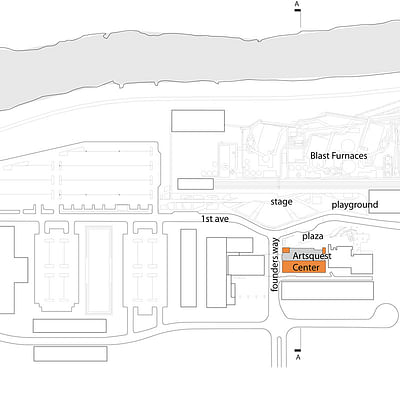

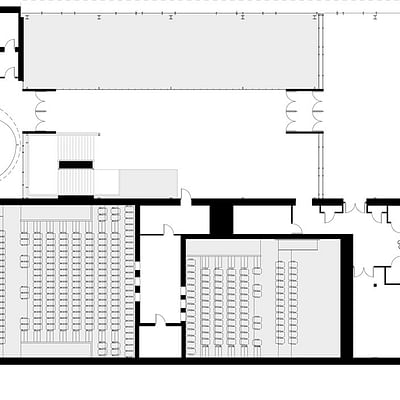
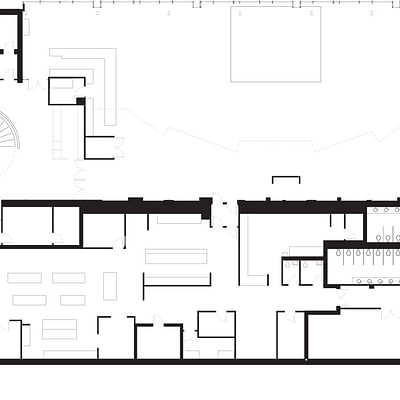



Share
0 Comments
Comment as :